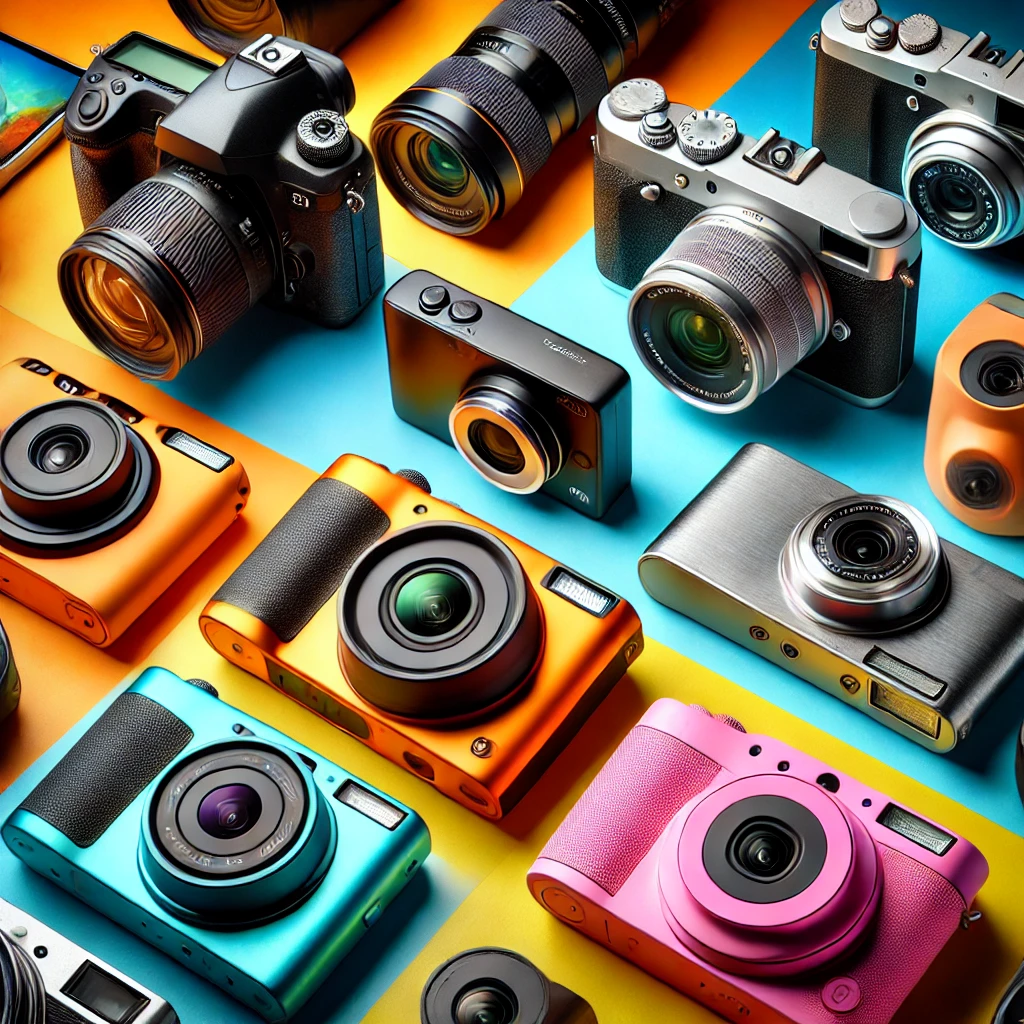Camera and Photography Buying Guide: Everything You Need to Know
Cameras and photography equipment have evolved significantly, offering incredible tools for everyone, from beginners to professional photographers. Choosing the right camera gear depends on your needs, skill level, and budget. This guide covers everything you need to know to make an informed decision.
Types of Cameras
DSLR Cameras
Purpose: Ideal for professional photographers who need versatility and control.
Popular Features: Interchangeable lenses, manual settings, optical viewfinders.
Top Brands: Canon, Nikon, Pentax.

Mirrorless Cameras
Purpose: Offer similar capabilities to DSLRs in a more compact design.
Popular Features: Electronic viewfinders, interchangeable lenses, 4K video.
Top Brands: Sony, Fujifilm, Panasonic.
Point-and-Shoot Cameras
Purpose: Great for casual photographers looking for simplicity and portability.
Popular Features: Fixed lenses, automatic settings, compact design.
Top Brands: Sony, Canon, Nikon.
Action Cameras
Purpose: Designed for capturing high-quality video and photos in extreme conditions.
Popular Features: Waterproof, 4K recording, image stabilization.
Top Brands: GoPro, DJI, Insta360.
Instant Cameras
Purpose: Perfect for fun, immediate photo printing.
Popular Features: Instant photo output, retro designs, easy operation.
Top Brands: Fujifilm, Polaroid.
Smartphone Cameras
Purpose: For convenience and everyday photography.
Popular Features: High-resolution sensors, AI enhancements, multiple lenses.
Top Brands: Apple, Samsung, Google.
Key Features to Consider
Sensor Size
Larger sensors (e.g., full-frame, APS-C) capture more light and detail, enhancing image quality.
Resolution
Measured in megapixels (MP). More MP provides better detail but is not the sole indicator of quality.
Lens Options
Interchangeable lenses provide versatility for different shooting styles, such as wide-angle, macro, or telephoto.
Video Capabilities
Look for features like 4K or 8K recording, slow motion, and high frame rates if you’re into videography.
Image Stabilization
Helps reduce blur from camera shake, especially useful for low-light photography or handheld videography.
Connectivity
Wi-Fi, Bluetooth, and NFC allow easy transfer of photos to your devices.
Battery Life
Essential for long shoots or travel; DSLR and mirrorless cameras usually have replaceable batteries.
Camera Accessories
Lenses
Prime Lenses: Fixed focal length for superior image quality.
Zoom Lenses: Versatile for various shooting scenarios.
Tripods
Provides stability for long exposure shots, videos, and time-lapses.
External Flashes
Offers better lighting control for portraits and low-light photography.
Filters
Enhance images with effects like polarization, ND (neutral density), or UV protection.
Memory Cards
Choose high-capacity, high-speed cards for faster writing and larger files.
Camera Bags
Protect your gear and make it easier to carry multiple items.
Choosing the Right Camera for Your Needs
Beginners
Start with an easy-to-use point-and-shoot or entry-level DSLR/mirrorless camera.
Travel Photographers
Compact and lightweight mirrorless cameras or smartphones with advanced features are ideal.
Action Enthusiasts
Opt for durable and waterproof action cameras with high frame rates and stabilization.
Professional Photographers
Invest in high-end DSLRs or mirrorless cameras with advanced features and lens systems.
Future Trends in Camera Technology
AI and Computational Photography: Advanced software-driven enhancements for superior quality.
8K Video Recording: High-resolution video becoming standard in professional-grade cameras.
Compact and Lightweight Designs: High performance in portable packages.
Enhanced Connectivity: Seamless integration with smart devices and cloud storage.
FAQs About Cameras and Photography
Do more megapixels mean better image quality?
Not always. Sensor size and lens quality play a bigger role in image quality.
What is the best camera for low-light photography?
Cameras with larger sensors and lenses with wide apertures perform better in low light.
How much should I spend on a camera?
It depends on your needs. Beginners can start with budget-friendly models ($300-$600), while professionals may invest in gear costing $2,000 or more.
By understanding the types, features, and accessories of cameras, you can choose equipment that suits your photography goals. Whether you’re capturing everyday moments, exploring creative photography, or pursuing a professional career, the right camera gear will empower your vision.
Disclaimer
Our buying guides are designed to help you make informed decisions by providing well-researched insights, product details, and expert recommendations. However, features, prices, and availability may change over time. We encourage you to verify information directly with manufacturers or sellers before purchasing. Your final choice should be based on personal research and preferences, and we are not responsible for any decisions made based on this guide.